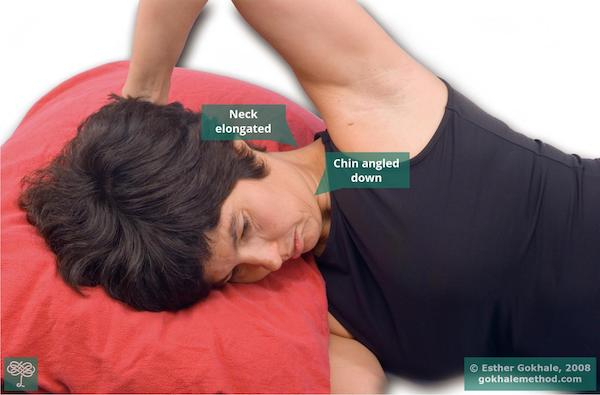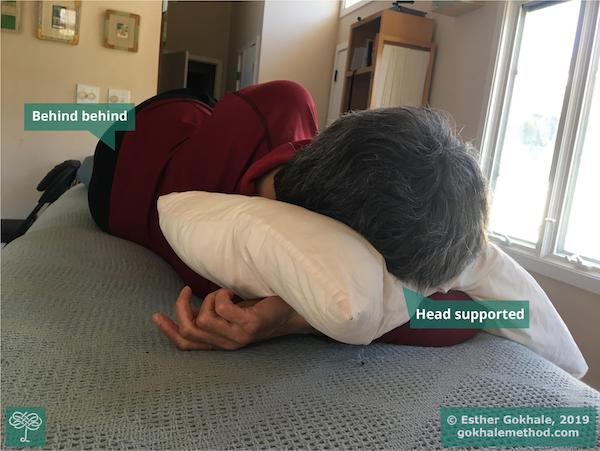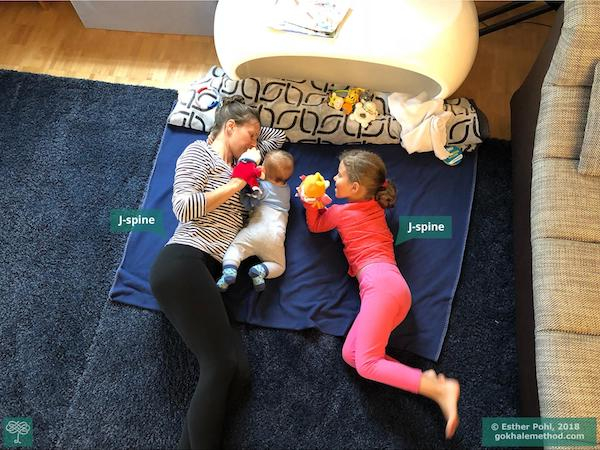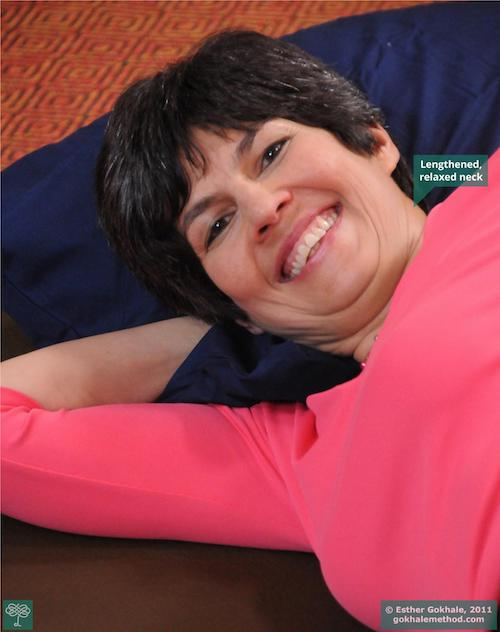I’ve taught stretchlying on the side for decades. So it’s a (welcome) surprise to discover a way of arranging the neck that is both more effective in adding additional neck length and more relaxing for the neck muscles.

It takes good form to be able to get rest on a surface this hard.

In July, reindeer herders in Samiland corral their reindeer to mark the ears of the unbranded calves. This involves stretches of waiting, some of it done reclining on the side, as above.
To date, I’ve taught students to grasp a clump of hair at the base of the skull and pull backward and upward so as to elongate the neck and slide the head back along the pillow into a healthier configuration.

Grasping the hair to guide the back of the head up and back.

My head is supported by a pillow and my forearm acting as a second pillow.
A new technique for lengthening the neck in stretchlying on the side
When I sleep on my side, I usually sleep on just one pillow and place my forearm under the pillow to add a second layer of thickness. Recently I discovered that I could use that forearm to manipulate my head position and enhance the stretch of the back of my neck. By slightly extending my forearm, I was able to elongate my neck further. Using my arm beneath the pillow, I was easily able to manipulate the pillow to move my head where I wanted it to go — rotated forward and glided back. This without tensing a single muscle in my neck and getting a better result — more fine-tuned and with a stronger stretch if that’s what I want (I do). The head’s journey back was very smooth — the pillow provides a soft, cushioned interface, and almost creates the illusion someone is doing the maneuver to you.

A supportive family supported by J-spines!

Forearm and pillow supporting an elongated neck. Enjoying a happy moment on the day of the public television program shoot.
Have you discovered extra techniques that improve your neck’s posture journey? Please do share your discoveries so everyone can benefit!



Comments
Thanks Esther, as always.
Thanks Esther, as always. Can you provide some guidance on how much neck extension one should aim for? That is, what technique do you use to know how far to go? Just before or after the point of discomfort? Well before the point of discomfort? This question holds for any of the stretches that you recommend.
Tony
My general view about pain
My general view about pain and discomfort is that Nature took a zillion years to design this system to tell you to stop / back off / do things differently, so I always advise people to pay attention to those messages. Stop at place that feels good, not bad.
Tiny note: in medicalese, "extension" for the neck means lifting your chin up; here we're dong the opposite. Of course, you were using the term in a correct colloquial way to mean "lengthen."
I was taught that the
I was taught that the expresion for the movement of the neck to bring the head forward or back is translation. Because people commonly develop a habitual anterior translation bringing the hed ito posterior translation makes ti apear longer and takes pressure off of the atlas /sull joint and cranial nerves.
How do you prevent your lower
How do you prevent your lower arm from falling asleep (from the pressure/weight on it) in this position?
malman below gives one good
malman below gives one good measure - use an extra head pillow. It's also helpful; to shift the lower shoulder forward a little so it's not pinned under the body.
I have found that placing
I have found that placing another pillow at a longwise angle under my lower ribcage helps keep my spine from bowing between head and hips, and gives my shoulder room underneath me so that I don't place my body weight fully upon it. This works whether I'm lying on my side or partial side front. It helps my whole spine align and it's then fairly easy to put the right amount of lift under my head to keep my neck aligned with the rest of my spine. Works for me, although may not work for everyone. I end up using more pillows, sometimes as many as four or five, (one also between my knees and feet), but I also don't feel a sore back upon waking.
I'll just start by saying
I'll just start by saying that I am a huge believer in the Gokhale method, and it has helped me tremendously. That said, I have owned a mattress store for 15 years, and I've spent tens of thousands of hours watching people on mattresses and correlating their pain with non-neutral sleeping positions. All of our customers are put on various pillows while they are selecting a mattress. In my experience, what you are recommending is what I term "a bad sleep habit". The job of the pillow is to pick up the 10-pound head and to keep that ten pounds from pushing the shoulder further into the mattress in a side sleeping position. Failure to pick up the head properly often results in a pressure point developing on the shoulder down in the mattress. I don't recommend any pillow which requires a body part (hand/arm) to be placed underneath the pillow to achieve a height that will actually support the head. There are several things that happen when a sleeper involves the arm or the hand in lifting the head by inserting it underneath the pillow. Firstly, the pressure of the 10-pound head on a hand/arm will create a circulation "pinch point", resulting in less robust circulation bodywide. Particularly as people age, muscle tone and connective tissue are not as robust as when young, so the nerves and vascular system are not as well-protected as they once were in locations like hips and shoulders ~ there is simply more pressure being exerted on nerves and vascular tissues. It becomes much easier to develop patches of tissue that are not well-oxygenated, causing ischemia as well as reducing the rate of circulation bodywide. Secondly, folding the arm under the head puts the shoulder joint in a torqued position (particularly in certain men who have a lot of upper body muscle), and often the elbow and wrist joints as well. As people age, it's important that these joints remain in as neutral a position as possible so that joint damage is not being caused or hastened by holding the joint in a torqued position for long periods of time. I have had hundreds of people call me or stop me on the street to thank me for the time I took with them to notice how they were lying on the mattresses, and for helping them solve their pain issues being caused by improper support of the head combined with joints held in non-neutral positions.
You make good points - this
You make good points - this technique does not generalize for everyone. That said, it's used successfully by people in many parts of the world, and works well for for some people in our culture (I'm one of them) - so use only if it makes sense and feels good.
Could you help me out with
Could you help me out with arm positioning when side sleeping ?
I struggle a lot with that.
This may already be included
This may already be included in what you're doing here.
Lying on side with arm under pillow, I've found the base of the skull (the slightly protruding bone under the ear, where head meets neck) can be "hitched" to the pilllow much in the way you teach hooking the back to the chair in stretch-sitting.
So, I extend the neck as far as I can, keeping shoulders in place, and hook the skull bone to the pillow. It stays put!! The stretch feels better than the somewhat scary traction device a physical therapist once strapped my my head and cranked with a winch (click clck click click! -- hoping not to hear the dreaded "pop!" )
Thank you for all your brilliant insights and advice
Roger B.
Cool and clever technique
Clever technique!
Most commercial traction devices pull the chin upwards - very different from pulling the back of the skull up. The first way actually shortens the neck; with the techniques described here, we're creating length in the neck.
(No subject)
Pillows I was born with that
Pillows I was born with that are always with me, made to fit:
I sleep only on my arms without a pillow. (I'm fatty enough to have cushiony arms) But sometimes I use a small blanket between my arm and head for extra padding, comfort or warmth. I find that not only does my arm-pillow provide an place for my ear to go and does not cover my nose, but it also seems to be just the right height to keep my neck in alignment with my back. I can use either arm, with elbow pointing toward my front or my back, or use both arms depending on my position. With two arms I can lay with my face toward the mattress and there is space for my nose and air! You can't do that with a pillow. As I get older, I feel that this nightly stretch of my shoulders keeps the flexibility of my shoulders. (I'm 59) There is no pressure on the shoulder that it toward the mattress because my armpit is what is facing the mattress, not bony point of my shoulder. It seems like my arm or arms were just made to be a pillow. Plus, I wash my two arm-pillows every time I shower so no dust mites!
(I will have to fool around more with adjusting my neck by stretching or opening my shoulders more, and bringing my head forward or back with the arm I am laying on.)
If you could have someone
If you could have someone take a picture, I'd love to see how you do that!
Besides the often compromised
Besides the often compromised neck position I, together with several physiotherapists, chiropractors etc. have found that sleeping on one's side causes chronic shoulder/arm pain, especially as one gets older. It happened to me. The weight on the arm throughout the night seems to be too much for shoulder and arm.
I have therefore trained myself to sleep on my back in a modified posture, with a long, open neck, one or both knees bent to side, like almost in a half-side lying position, but shoulders relaxed, back, down and wide on the mattress. I wedge a pillow under my one hip or waist. It took me a while, but now I sleep better in this position than on the side. My shoulders are not sore any more, my neck does not feel stiff, my back feels releaxed and lengthened. If I try lie on my side, my shoulder and arm get painful again very quickly.
What are your thoughts on this problem, Esther?
Because we have 7 small
Because we have 7 small verteba in the neck and 5 large ones in the low back the actual center of rotation is between the shoulder blades T5/6. Therfore in the position you describe the upper vertabra will unwind in the oposit direction which is very helpfull. to obtain the J shape in the low back I reccomend straightening the lower leg and bringing the upper leg closer to the tummy for 2 to 5 minutes then do it on the other side. This restores the propper rotation of each segment of the spine for the walking reflex.
I I really wish I could iie
I I really wish I could iie on my side but shoulders seems to fall in when I do that. As I age I have issues with connectie tissue and shoulders collapse. I have also had to learn to lie half side lying half backlying but would love ideas to keep neck extended, shoulders open and a j spine. in this position.